2018年全国一卷英语试题答案解析
2018高考英语真题试卷全国一卷(含答案和解析)
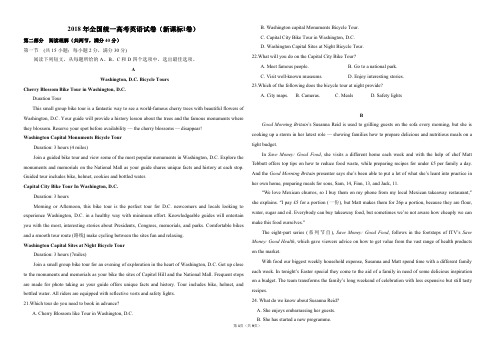
2018年全国统一高考英语试卷(新课标Ⅰ卷)第二部分阅读理解(共两节,满分40分)第一节(共15小题;每小题2分,满分30分)阅读下列短文,从每题所给的A、B、C和D四个选项中,选出最佳选项。
AWashington,D.C.Bicycle ToursCherry Blossom Bike Tour in Washington,D.C.Duration TourThis small group bike tour is a fantastic way to see a world-famous cherry trees with beautiful flowers of Washington,D.C.Your guide will provide a history lesson about the trees and the famous monuments where they blossom.Reserve your spot before availability—the cherry blossoms—disappear!Washington Capital Monuments Bicycle TourDuration:3hours(4miles)Join a guided bike tour and view some of the most popular monuments in Washington,D.C.Explore the monuments and memorials on the National Mall as your guide shares unique facts and history at each stop. Guided tour includes bike,helmet,cookies and bottled water.Capital City Bike Tour In Washington,D.C.Duration:3hoursMorning or Afternoon,this bike tour is the perfect tour for D.C.newcomers and locals looking to experience Washington,D.C.in a healthy way with minimum effort.Knowledgeable guides will entertain you with the most,interesting stories about Presidents,Congress,memorials,and fortable bikes and a smooth tour route(路线)make cycling between the sites fun and relaxing.Washington Capital Sites at Night Bicycle TourDuration:3hours(7miles)Join a small group bike tour for an evening of exploration in the heart of Washington,D.C.Get up close to the monuments and memorials as your bike the sites of Capitol Hill and the National Mall.Frequent stops are made for photo taking as your guide offers unique facts and history.Tour includes bike,helmet,and bottled water.All riders are equipped with reflective vests and safety lights.21.Which tour do you need to book in advance?A.Cherry Blossom like Tour in Washington,D.C.B.Washington capital Monuments Bicycle Tour.C.Capital City Bike Tour in Washington,D.C.D.Washington Capital Sites at Night Bicycle Tour.22.What will you do on the Capital City Bike Tour?A.Meet famous people.B.Go to a national park.C.Visit well-known museums.D.Enjoy interesting stories.23.Which of the following does the bicycle tour at night provide?A.City maps.B.Cameras.C.MealsD.Safety lightsBGood Morning Britain’s Susanna Reid is used to grilling guests on the sofa every morning,but she is cooking up a storm in her latest role—showing families how to prepare delicious and nutritious meals on a tight budget.In Save Money:Good Food,she visits a different home each week and with the help of chef Matt Tebbutt offers top tips on how to reduce food waste,while preparing recipes for under£5per family a day. And the Good Morning Britain presenter says she’s been able to put a lot of what she’s leant into practice in her own home,preparing meals for sons,Sam,14,Finn,13,and Jack,11.“We love Mexican churros,so I buy them on my phone from my local Mexican takeaway restaurant,”she explains.“I pay£5for a portion(一份),but Matt makes them for26p a portion,because they are flour, water,sugar and oil.Everybody can buy takeaway food,but sometimes we’re not aware how cheaply we can make this food ourselves.”The eight-part series(系列节自),Save Money:Good Food,follows in the footsteps of ITV’s Save Money:Good Health,which gave viewers advice on how to get value from the vast range of health products on the market.With food our biggest weekly household expense,Susanna and Matt spend time with a different family each week.In tonight’s Easter special they come to the aid of a family in need of some delicious inspiration on a budget.The team transforms the family’s long weekend of celebration with less expensive but still tasty recipes.24.What do we know about Susanna Reid?A.She enjoys embarrassing her guests.B.She has started a new programme.C.She dislikes working early in the morning.D.She has had a light budget for her family.25.How does Matt Tebbutt help Susanna?A.He buys cooking materials for her.B.He prepares food for her kids.C.He assists her in cooking matters.D.He invites guest families for her.26.What does the author intend to do in paragraph4?A.Summarize the previous paragraphs.B.Provide some advice for the readers.C.Add some background information.D.Introduce a new topic for discussion.27.What can be a suitable title for the text?A.Keeping Fit by Eating SmartB.Balancing Our Daily DietC.Making yourself a Perfect ChefD.Cooking Well for LessCLanguages have been coming and going for thousands of years,but in recent times there has been less coming and a lot more going.When the the world was still populated by hunter-gatherers,small,tightly knit (联系)groups developed their own patterns of speech independent of each other.Some language experts believe that10,000years ago,when the world had just five to ten million people,they spoke perhaps12,000 languages between them.Soon afterwards,many of those people started settling down to become farmers,and their languages too became more settled and fewer in number.In recent centres,trade,industrialisation,the development of the nation-state and the spread of universal compulsory education.Especially glbalisation and better communications in the past few decades,all have caused many Languages to disappear,and dominant languages such as English.Spanish and Chinese are increasingly taking over.At present,the world has about6,800languages.The distribution of these languages is hugely uneven. The general rule is that mild zones have relatively few languages.Often spoken by many people while hot,wet zones have lots,often spoken by small numbers.Europe has only around200Languages:the Americas about1,000.Africa2,400;and Asia and the Pacific perhaps3,200,of which Papua New Guinea alone accounts for well over800.The median number(中位数)of speakers is a mere6.000,which means that half the worlds languages are spoken by fewer people than that.Already well over400of the total of6,800languages are close to extinction(消亡),with only a few elderly speakers left.Pick,at random,Busuu in Cameroon(eight remaining speakers),Chiapaneco in Mexico(150).Lipan Apache in the United States(two or three)or Wadjigu in Australia(one,with a question-mark):none of these seems to have much chance of survival.28.What can we infer about languages in huntergatherer times?A.They developed very fast.B.They were large in number.C.They had similar patters.D.They were closely connected29.Which of the following best explains“dominant”underlined in paragraph2?plex.B.Advanced.C.Powerful.D.Modem.30.How many languages are spoken by less than6,000people at present?A.About6,800.B.About3,400.C.About2,400.D.About1,200.31.What is the min idea of the text?A.New languages will be created.B.Peoples lifestyles are reflected in languagesC.Human development results in fewer languagesD.Geography determines language evolution.DWe may think we’re a culture that gets rid of our worn technology at the first sight of something shiny and new,but a new study shows that we keep using our old devices(装置)well after they go out of style. That’s bad news for the environment—and our wallets—as these outdated devices consume much more energy than the newer ones that do the same things.To figure out how much power these devices are using,Callie Babbitt and her colleagues at the Rochester Institute of Technology in New York tracked the environmental costs for each product throughout its life—from when its minerals are mined to when we stop using the device.This method provided a readout for how home energy use has evolved since the early1990s.Devices were grouped by generation—Desktop computers,basic mobile phones,and box-set TVs defined1992.Digital cameras arrived on thescene in1997.And MP3players,smart phones,and LCD TVs entered homes in2002,before tablets and e-readers showed up in2007.As we accumulated more devices,however,we didn’t throw out our old ones.“The living-room television is replaced and gets planted in the kids’room,and suddenly one day,you have a TV in every room of the house,”said one researcher.The average number of electronic devices rose from four per household in 1992to13in2007.We’re not just keeping these old devices—we continue to use them.According to the analysis of Babbitt’s team,old desktop monitors and box TVs with cathode ray tubes are the worst devices with their energy consumption and contribution to greenhouse gas emissions(排放)more than doubling during the1992to2007window.So what’s the solution(解决方案)?The team’s data only went up to2007,but the researchers also explored what would happen if consumers replaced old products with new electronics that serve more than one function,such as a tablet for word processing and TV viewing.They found that more on-demand entertainment viewing on tablets instead of TVs and desktop computers could cut energy consumption by 44%.32.What does the author think of new devices?A.They are environment-friendly.B.They are no better than the old.C.They cost more to use at home.D.They go out of style quickly.33.Why did Babbitt’s team conduct the research?A.To reduce the cost of minerals.B.To test the life cycle of a product.C.To update consumers on new technology.D.To find out electricity consumption of the devices.34.Which of the following uses the least energy?A.The box-set TV.B.The tablet.C.The LCD TV.D.The desktop computer.35.What does the text suggest people do about old electronic devices?A.Stop using them.B.Take them apart.C.Upgrade them.D.Recycle them.第二节(共5小题;每小题2分,满分10分)Color is fundamental in home design—something you’ll always have in every room.A grasp of how to manage color in your spaces is one of the first steps to creating rooms you’ll love to live in.Do you want a room that’s full of life?Professional?Or are you just looking for a place to relax after a long day?36, color is the key to making a room feel the way you want it to feel.Over the years,there have been a number of different techniques to help designers approach this important point.37,they can get a little complex.But good news is that there’re really only three kinds of decisions you need to make about color in your home:the small ones,the medium ones,and the large ones.38.They’re the little spots of color like throw pillows,mirrors and baskets that most of us use to add visual interest to our rooms.Less tiring than painting your walls and less expensive than buying a colorful sofa,small color choices bring with them the significant benefit of being easily changeable.Medium color choices are generally furniture pieces such as sofas,dinner tables or bookshelves 39.They require a bigger commitment than smaller ones,and they have a more powerful effect on the feeling of a space.The large color decisions in your rooms concern the walls,ceilings,and floors.Whether you’re looking at wallpaper or paint,the time,effort and relative expense put into it are significant.40.A.While all of them are usefulB.Whatever you’re looking forC.If you’re experimenting with a colorD.Small color choices are the ones we’re most familiar withE.It’s not really a good idea to use too many small color piecesF.So it pays to be sure,because you want to get it right the first timeG.Color choices in this range are a step up from the small ones in two major ways第三部分语言知识运用(共两节,满分45分)第一节完形填空(共20小题;每小题1.5分,满分30分)阅读下面短文,从短文后各题所给的A、B、C和D四个选项中,选出可以填入空白处的最佳选项。
2018年高考英语全国1卷与答案.doc
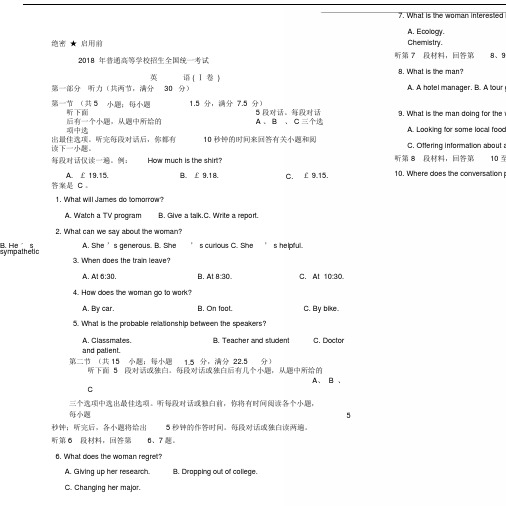
绝密★启用前2018 年普通高等学校招生全国统一考试英语 ( Ⅰ卷 )第一部分听力(共两节,满分30 分)第一节(共 5 小题;每小题 1.5 分,满分 7.5 分)听下面 5 段对话。
每段对话后有一个小题,从题中所给的 A 、 B 、 C 三个选项中选10 秒钟的时间来回答有关小题和阅出最佳选项。
听完每段对话后,你都有读下一小题。
每段对话仅读一遍。
例:How much is the shirt?A. £ 19.15.B. £ 9.18.C. £ 9.15.答案是 C 。
1. What will James do tomorrow?A. Watch a TV programB. Give a talk.C. Write a report.2. What can we say about the woman?A. She ’s generous.B. She ’ s curiousC. She ’ s helpful.3. When does the train leave?A. At 6:30.B. At 8:30.C. At 10:30.4. How does the woman go to work?A. By car.B. On foot.C. By bike.5. What is the probable relationship between the speakers?A. Classmates.B. Teacher and studentC. Doctorand patient.第二节(共 15 小题;每小题 1.5 分,满分 22.5 分)听下面 5 段对话或独白。
每段对话或独白后有几个小题,从题中所给的CA、 B 、三个选项中选出最佳选项。
听每段对话或独白前,你将有时间阅读各个小题,每小题 5 秒钟;听完后,各小题将给出 5 秒钟的作答时间。
每段对话或独白读两遍。
听第 6段材料,回答第6、7 题。
2018年普通高等学校招生全国统一考试英语(全国卷1)及答案解析

2018年普通高等学校招生全国统一考试英语(全国卷1)及答案解析英语第一部分听力 (共两节,满分30分做题时,先将答案标在试卷上。
录音内容结束后,你将有两分钟的时间将试卷上的答案转涂到答题卡上。
第一节(共5小题;每小题1.5分,满分7.5分)听下面5段对话,每段对话后有一个小题,从题中所给的A、B、C三个选项中选出最佳选项。
听完每段对话后,你都有10秒钟的时间来回答有关小题和阅读下一小题。
每段对话仅读一遍。
例: How much is the shirt?A. £19.15.B. £ 9.18.C. £ 9.15.答案是C。
1. What will James do tomorrow?A. Watch a TV program.B. Give atalk. C. Write a report.2. What can we say about the woman?A. She’s generous.B. She’s curious.C. She’s helpful.3. When does the train leave?A. At 6:30.B. At 8:30.C. At 10:304. How does the woman go to work?A. By carB. On footC. By bike.5. What is the probable relationship between the speakers?A. Classmates.B. Teacher and student.C. Doctor and patient.第二节(共15小题; 每小题1.5分。
满分22.5分)听下面5段对话或独白。
每段对话或独白后有几个小题,从题中所给的A、B、C三个选项中选出最佳选项。
听每段对话或独白前,你将有时间阅读各个小题,每小题5秒钟,听完后,各小题将给出5秒钟的作答时间。
2018年高考全国1卷英语试题(含答案).doc
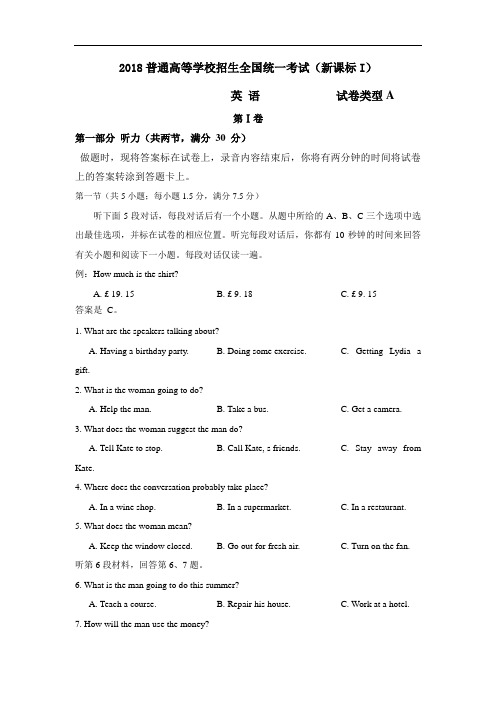
2018普通高等学校招生全国统一考试(新课标I)英语试卷类型A第Ⅰ卷第一部分听力(共两节,满分30 分)做题时,现将答案标在试卷上,录音内容结束后,你将有两分钟的时间将试卷上的答案转涂到答题卡上。
第一节(共5小题;每小题1.5分,满分7.5分)听下面5段对话,每段对话后有一个小题。
从题中所给的A、B、C三个选项中选出最佳选项,并标在试卷的相应位置。
听完每段对话后,你都有10秒钟的时间来回答有关小题和阅读下一小题。
每段对话仅读一遍。
例:How much is the shirt?A. £ 19. 15B. £ 9. 18C. £ 9. 15答案是C。
1. What are the speakers talking about?A. Having a birthday party.B. Doing some exercise.C. Getting Lydia a gift.2. What is the woman going to do?A. Help the man.B. Take a bus.C. Get a camera.3. What does the woman suggest the man do?A. Tell Kate to stop.B. Call Kate, s friends.C. Stay away from Kate.4. Where does the conversation probably take place?A. In a wine shop.B. In a supermarket.C. In a restaurant.5. What does the woman mean?A. Keep the window closed.B. Go out for fresh air.C. Turn on the fan.听第6段材料,回答第6、7题。
2018年高考英语试题一卷及答案解析
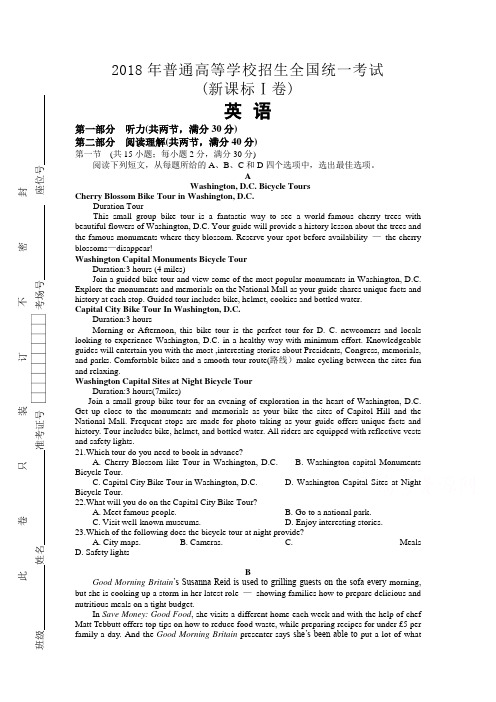
2018年普通高等学校招生全国统一考试 (新课标Ⅰ卷) 英 语 第一部分 听力(共两节,满分30分) 第二部分 阅读理解(共两节,满分40分) 第一节 (共15小题;每小题2分,满分30分) 阅读下列短文,从每题所给的A 、B 、C 和D 四个选项中,选出最佳选项。
A Washington, D.C. Bicycle Tours Cherry Blossom Bike Tour in Washington, D.C. Duration Tour This small group bike tour is a fantastic way to see a world-famous cherry trees with beautiful flowers of Washington, D.C. Your guide will provide a history lesson about the trees and the famous monuments where they blossom. Reserve your spot before availability — the cherry blossoms —disappear! Washington Capital Monuments Bicycle Tour Duration:3 hours (4 miles) Join a guided bike tour and view some of the most popular monuments in Washington, D.C. Explore the monuments and memorials on the National Mall as your guide shares unique facts and history at each stop. Guided tour includes bike, helmet, cookies and bottled water. Capital City Bike Tour In Washington, D.C. Duration:3 hours Morning or Afternoon, this bike tour is the perfect tour for D. C. newcomers and locals looking to experience Washington, D.C. in a healthy way with minimum effort. Knowledgeable guides will entertain you with the most ,interesting stories about Presidents, Congress, memorials, and parks. Comfortable bikes and a smooth tour route(路线)make cycling between the sites fun and relaxing. Washington Capital Sites at Night Bicycle Tour Duration:3 hours(7miles) Join a small group bike tour for an evening of exploration in the heart of Washington, D.C. Get up close to the monuments and memorials as your bike the sites of Capitol Hill and the National Mall. Frequent stops are made for photo taking as your guide offers unique facts and history. Tour includes bike, helmet, and bottled water. All riders are equipped with reflective vests and safety lights. 21.Which tour do you need to book in advance? A. Cherry Blossom like Tour in Washington, D.C. B. Washington capital Monuments Bicycle Tour. C. Capital City Bike Tour in Washington, D.C. D. Washington Capital Sites at Night Bicycle Tour. 22.What will you do on the Capital City Bike Tour? A. Meet famous people. B. Go to a national park. C. Visit well-known museums. D. Enjoy interesting stories. 23.Which of the following does the bicycle tour at night provide? A. City maps. B. Cameras. C. Meals D. Safety lights B Good Morning Britain ’s Susanna Reid is used to grilling guests on the sofa every morning, but she is cooking up a storm in her latest role — showing families how to prepare delicious and nutritious meals on a tight budget. In Save Money: Good Food , she visits a different home each week and with the help of chef Matt Tebbutt offers top tips on how to reduce food waste, while preparing recipes for under £5 per family a day. And the Good Morning Britain presenter say s she’s been able to put a lot of what 此卷只装订不密封班级 姓名 准考证号 考场号 座位号she’s leant into practice in her own home, preparing meals for sons, Sam,14, Finn,13, and Jack, 11."We love Mexican churros, so I buy them on my phone from my local Mexican takeaway restaurant," she explains. "I pay £5 for a portion(一份), but Matt makes them for 26p a portion, because they are flour, water, sugar and oil. Everybody can buy takeaway food, but sometimes we’re not aware how cheaply we can make this food ourselv es. "The eight-part series(系列节自), Save Money: Good Food, follows in the footsteps of ITV’s Save Money: Good Health, which gave viewers advice on how to get value from the vast range of health products on the market.With food our biggest weekly household expense, Susanna and Matt spend time with a different family each week. In tonight’s Easter special they come to the aid of a family in need of some delicious inspiration on a budget. The team transforms the family’s long weekend of celebration with less expensive but still tasty recipes.24. What do we know about Susanna Reid?A. She enjoys embarrassing her guests.B. She has started a new programme.C. She dislikes working early in the morning.D. She has had a light budget for her family.25. How does Matt Tebbutt help Susanna?A. He buys cooking materials for her.B. He prepares food for her kids.C. He assists her in cooking matters.D. He invites guest families for her.26. What does the author intend to do in paragraph 4?A. Summarize the previous paragraphs.B. Provide some advice for the readers.C. Add some background information.D. Introduce a new topic for discussion.27. What can be a suitable title for the text?A. Keeping Fit by Eating SmartB. Balancing Our Daily DietC. Making yourself a Perfect ChefD. Cooking Well for LessCLanguages have been coming and going for thousands of years, but in recent times there has been less coming and a lot more going. When the the world was still populated by hunter-gatherers,small, tightly knit (联系)groups developed their own patterns of speech independent of each other.Some language experts believe that 10,000 years ago, when the world had just five to ten million people, they spoke perhaps 12,000 languages between them.Soon afterwards, many of those people started settling down to become farmers, and their languages too became more settled and fewer in number. In recent centres, trade,industrialisation. the development of the nation-state and the spread of universal compulsory education. Especially glbalisation and better communications in the past few decades,all have caused many Languages to disappear,and dominant languages such as English.Spanish and Chinese are increasingly taking over.At present, the world has about 6 800 languages. The distribution of these languages is hugely uneven. The general rule is that mild zones have relatively few languages. Often spoken by many people while hot. wet zones have lots, often spoken by small numbers.Europe has only around 200 Languages: the Americas about 1,000. Africa 2 400; and Asia and the Pacific perhaps 3,200, of which Papua New Guinea alone accounts for well over 800. The median number (中位数)of speakers is a mere 6.000, which means that half the worlds languages are spoken by fewer people than that.Already well over 400 of the total of, 6,800 languages are close to extinction(消亡), with only a few elderly speakers left. Pick, at random, Busuu in Cameroon (eight remaining speakers),Chiapaneco in Mexico(150). Lipan Apache in the United States(two or three)or Wadjigu in Australia (one, with a question-mark): none of these seems to have much chance of survival.28. What can we infer about languages in huntergatherer times?A.They developed very fast.B. They were large in number.C. They had similar patters.D. They were closely connected29. Which of the following best explains"dominant " underlined in paragraph 2?plex.B. Advanced.C.Powerful.D.Modem.30. How many languages are spoken by less than 6, 000 people at present?A.About 6 800B.About 3 400C.About 2.400D.About 1-20031. What is the min idea of the text?A. New languages will be created.B Peoples lifestyles are reflected in languagesC. Human development results in fewer languagesD. Geography determines language evolution.DWe may think we're a culture that gets rid of our worn technology at the first sight of something shiny and new, but a new study shows that we keep using our old devices(装置) well after they go out of style. That’s bad news for the environment—and our wallets —as these outdated devices consume much more energy than the newer ones that do the same things.To figure out how much power these devices are using, Callie Babbitt and her colleagues at the Rochester Institute of Technology in New York tracked the environmental costs for each product throughout its life — from when its minerals are mined to when we stop using the device. This method provided a readout for how home energy use has evolved since the early 1990s. Devices were grouped by generation —Desktop computers, basic mobile phones, and box-set TVs defined 1992. Digital cameras arrived on the scene in 1997. And MP3 players, smart phones, and LCD TVs entered homes in 2002, before tablets and e-readers showed up in 2007.As we accumulated more devices, however, we didn't throw out our old ones. "The living-room television is replaced and gets planted in the kids' room, and suddenly one day, you have a TV in every room of the house," said one researcher. The average number of electronic devices rose from four per household in 1992 to 13 in 2007. We're not just keeping these old devices —we continue to use them. According to the analysis of Babbitt's team, old desktop monitors and box TVs with cathode ray tubes are the worst devices with their energy consumption and contribution to greenhouse gas emissions(排放)more than doubling during the 1992 to 2007 window.So what's the solution(解决方案)? The team's data only went up to 2007, but the researchers also explored what would happen if consumers replaced old products with new electronics that serve more than one function, such as a tablet for word processing and TV viewing. They found that more on-demand entertainment viewing on tablets instead of TVs and desktop computers could cut energy consumption by 44%.32. What does the author think of new devices?A. They are environment-friendly.B. They are no better than the old.C. They cost more to use at home.D. They go out of style quickly.33. Why did Babbitt's team conduct the research?A. To reduce the cost of minerals.B. To test the life cycle of a product.C. To update consumers on new technology.D. To find out electricity consumption of the devices.34. Which of the following uses the least energy?A. The box-set TV.B. The tablet.C. The LCD TV.D. The desktop computer.35. What does the text suggest people do about old electronic devices?A. Stop using them.B. Take them apart.C. Upgrade them.D. Recycle them.第二节(共5小题;每小题2分,满分10分)根据短文内容,从短文后的选项中选出能填入空白处的最佳选项。
2018高考英语[全国I卷]试题和参考答案解析[版]
![2018高考英语[全国I卷]试题和参考答案解析[版]](https://img.taocdn.com/s3/m/22cb0ed0a8956bec0975e3c1.png)
绝密★启用前2018年普通高等学校招生全国统一考试英语注意事项:1.答卷前,考生务必将自己的姓名、准考证号填写在答题卡上。
2.回答选择题时,选出每小题答案后,用铅笔把答题卡上对应题目的答案标号涂黑。
如需改动,用橡皮擦干净后,再选涂其他答案标号。
回答非选择题时,将答案写在答题卡上,写在本试卷上无效。
3.考试结束后,将本试卷和答题卡一并交回。
第一部分听力(共两节,满分30分)做题时,先将答案标在试卷上。
录音内容结束后,你将有两分钟的时间将试卷上的答案转涂到答题卡上。
第一节(共5小题;每小题1.5分,满分7.5分)听下面5段对话。
每段对话后有一个小题,从题中所给的A、B、C三个选项中选出最佳选项。
听完每段对话后,你都有10秒钟的时间来回答有关小题和阅读下一小题。
每段对话仅读一遍。
例:How much is the shirt?A. £19.15.B. £9.18.C. £9.15.答案是C。
1. What will James do tomorrow?A. Watch a TV program.B. Give a talk.C. Write a report.2. What can we say about the woman?A. She’s generous.B. She’s curious.C. She’s helpful.3. When does the train leave?A. At 6:30.B. At 8:30.C. At 10:30.4. How does the woman go to work?A. By car.B. On foot.C. By bike.5. What is the probable relationship between the speakers?A. Classmates.B. Teacher and student.C. Doctor and patient. . .专业知识分享. .第二节(共15小题;每小题1.5分,满分22.5分)听下面5段对话或独白。
2018年高考英语全国1卷(附答案)
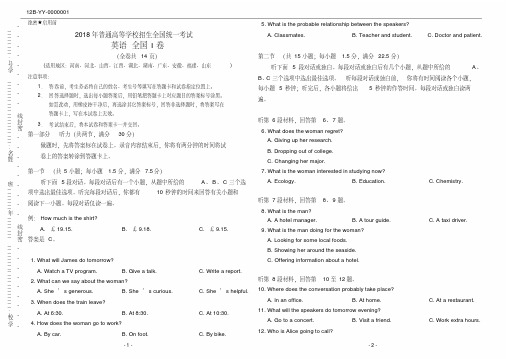
学校:___________________________年_______班姓名:____________________学号:________---------密封线---------密封线---------绝密★启用前2018年普通高等学校招生全国统一考试英语全国I 卷(全卷共14页)(适用地区:河南、河北、山西、江西、湖北、湖南、广东、安徽、福建、山东)注意事项:1.答卷前,考生务必将自己的姓名、考生号等填写在答题卡和试卷指定位置上。
2.回答选择题时,选出每小题答案后,用铅笔把答题卡上对应题目的答案标号涂黑。
如需改动,用橡皮擦干净后,再选涂其它答案标号,回答非选择题时,将答案写在答题卡上,写在本试卷上无效。
3.考试结束后,将本试卷和答案卡一并交回。
第一部分听力(共两节,满分30分)做题时,先将答案标在试卷上。
录音内容结束后,你将有两分钟的时间将试卷上的答案转涂到答题卡上。
第一节(共5小题;每小题1.5分,满分7.5分)听下面5段对话。
每段对话后有一个小题,从题中所给的A 、B 、C 三个选项中选出最佳选项。
听完每段对话后,你都有10秒钟的时间来回答有关小题和阅读下一小题。
每段对话仅读一遍。
例:How much is the shirt?A. £19.15.B. £9.18.C. £9.15.答案是C 。
1. What will James do tomorrow? A. Watch a TV program.B. Give a talk.C. Write a report.2. What can we say about the woman?A. She ’s generous. B. She ’s curious.C. She ’s helpful.3. When does the train leave?A. At 6:30.B. At 8:30.C. At 10:30.4. How does the woman go to work? A. By car.B. On foot.C. By bike.5. What is the probable relationship between the speakers?A. Classmates.B. Teacher and student.C. Doctor and patient.第二节(共15小题;每小题 1.5分,满分22.5分)听下面5段对话或独白。
2018年高考英语试题全国卷一(含答案)
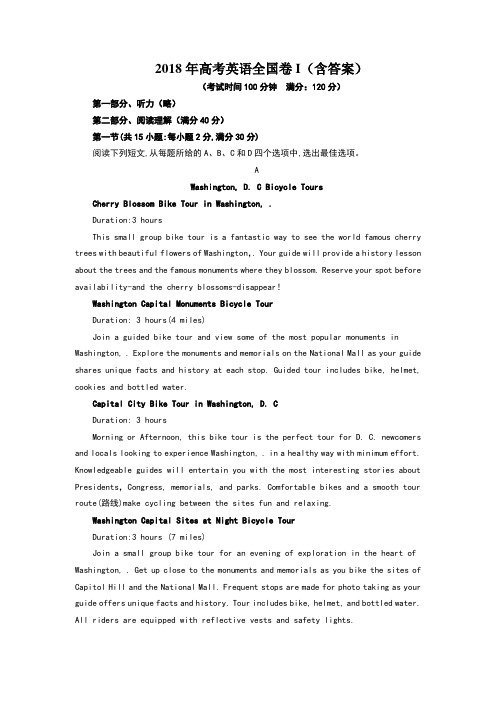
2018年高考英语全国卷I(含答案)(考试时间100分钟满分:120分)第一部分、听力(略)第二部分、阅读理解(满分40分)第一节(共15小题:每小题2分,满分30分)阅读下列短文,从每题所给的A、B、C和D四个选项中,选出最佳选项。
AWashington, D. C Bicycle ToursCherry Blossom Bike Tour in Washington, .Duration:3 hoursThis small group bike tour is a fantastic way to see the world famous cherry trees with beautiful flowers of Washington,. Your guide will provide a history lesson about the trees and the famous monuments where they blossom. Reserve your spot before availability-and the cherry blossoms-disappear!Washington Capital Monuments Bicycle TourDuration: 3 hours(4 miles)Join a guided bike tour and view some of the most popular monuments in Washington, . Explore the monuments and memorials on the National Mall as your guide shares unique facts and history at each stop. Guided tour includes bike, helmet, cookies and bottled water.Capital City Bike Tour in Washington, D. CDuration: 3 hoursMorning or Afternoon, this bike tour is the perfect tour for D. C. newcomers and locals looking to experience Washington, . in a healthy way with minimum effort. Knowledgeable guides will entertain you with the most interesting stories about Presidents,Congress, memorials, and parks. Comfortable bikes and a smooth tour route(路线)make cycling between the sites fun and relaxing.Washington Capital Sites at Night Bicycle TourDuration:3 hours (7 miles)Join a small group bike tour for an evening of exploration in the heart of Washington, . Get up close to the monuments and memorials as you bike the sites of Capitol Hill and the National Mall. Frequent stops are made for photo taking as your guide offers unique facts and history. Tour includes bike, helmet, and bottled water. All riders are equipped with reflective vests and safety lights.tour do you need to book in advanceBlossom Bike Tour in Washington, .Capital Monuments Bicycle Tour.City Bike Tour in Washington, D. CCapital Sites at Night Bicycle Tour.22. What will you do on the Capital City Bike Tourfamous people. to a national park.well-known museums. interesting stories.23. Which of the following does the bicycle tour at night providemaps. . . lights.BGood Morning Britain's Susanna Reid is used to grilling guests on the sofa every morning,but she is cooking up a storm in her latest role - showing families how to prepare delicious and nutritious meals on a tight budget。
2018年高考全国Ⅰ卷英语试卷(含参考答案)

绝密★启用前2018年普通高等学校招生全国统一考试英语(考试时间:120分钟试卷满分:150分)注意事项:1. 答卷前,考生务必将自己的姓名、准考证号填写在答题卡上。
2. 回答选择题时,选出每小题答案后,用铅笔把答题卡上对应题目的答案标号涂黑。
如需改动,用橡皮擦干净后,再选涂其他答案标号。
回答非选择题时,将答案写在答题卡上,写在本试卷上无效。
3. 考试结束后,将本试卷和答题卡一并交回。
第一部分听力(共两节,满分30分)做题时,先将答案标在试卷上。
录音内容结束后,你将有两分钟的时间将试卷上的答案转涂到答题卡上。
第一节(共5小题;每小题1.5分,满分7.5分)听下面5段对话。
每段对话后有一个小题,从题中所给的A、B、C三个选项中选出最佳选项。
听完每段对话后,你都有10秒钟的时间来回答有关小题和阅读下一小题。
每段对话仅读一遍。
例:How much is the shirt?A. £ 19. 15.B. £ 9. 18.C. £ 9. 15.答案是C。
1.what will James do tomorrow ?A.Watch a TV program.B.Give a talk.C.Write a report.2.What can we say about the woman?A.She's generour.B.She's curious.C.She's helpful.3.When does the traif leave?A.At 6:30.B.At8:30.C.At 10:30.4.How does the wonar sRwr?mA.By car.B.On foot.C.By bike5.What is the probable relationship between the speakers?A.Classmates.B.Teacher and student.C.Doctor and patient. 第二节(共15小题;每小题1.5分,满分22.5分)听下面5段对话或独白。
2018高考英语全国1卷试题和答案解析[清晰版]
![2018高考英语全国1卷试题和答案解析[清晰版]](https://img.taocdn.com/s3/m/6e2abd50caaedd3383c4d3da.png)
绝密★启用前2018年普通高等学校招生全国统一考试英语注意事项:1.答卷前,考生务必将自己的姓名、准考证号填写在答题卡上。
2.回答选择题时,选出每小题答案后,用铅笔把答题卡上对应题目的答案标号涂黑。
如需改动,用橡皮擦干净后,再选涂其他答案标号。
回答非选择题时,将答案写在答题卡上,写在本试卷上无效。
3.考试结束后,将本试卷和答题卡一并交回。
第一部分听力(共两节,满分30分)做题时,先将答案标在试卷上。
录音内容结束后,你将有两分钟的时间将试卷上的答案转涂到答题卡上。
第一节(共5小题;每小题1.5分,满分7.5分)听下面5段对话。
每段对话后有一个小题,从题中所给的A、B、C三个选项中选出最佳选项。
听完每段对话后,你都有10秒钟的时间来回答有关小题和阅读下一小题。
每段对话仅读一遍。
例:How much is the shirt?A. £19.15.B. £9.18.C. £9.15.答案是C。
1. What will James do tomorrow?A. Watch a TV program.B. Give a talk.C. Write a report.2. What can we say about the woman?A. She’s generous.B. She’s curious.C. She’s helpful.3. When does the train leave?A. At 6:30.B. At 8:30.C. At 10:30.4. How does the woman go to work?A. By car.B. On foot.C. By bike.5. What is the probable relationship between the speakers?A. Classmates.B. Teacher and student.C. Doctor and patient.专业知识分享第二节(共15小题;每小题1.5分,满分22.5分)听下面5段对话或独白。
2018年高考真题英语全国1卷含答案

2018年高考真题英语全国1卷含答案2018年普通高等学校招生全国统一考试全国I卷英语(含参考答案)注意事项:1. 答卷前,考生务必将自己的姓名、准考证号填写在答题卡上。
2. 回答选择题时,选出每小题答案后,用铅笔把答题卡上对应题目的答案标号涂黑。
如需改动,用橡皮擦干净后,再选涂其他答案标号。
回答非选择题时,将答案写在答题卡上,写在本试卷上无效。
3. 考试结束后,将本试卷和答题卡一并交回。
第一部分听力(共两节,满分30分)做题时,先将答案标在试卷上。
录音内容结束后,你将有两分钟的时间将试卷上的答案转涂到答题卡上。
第一节(共5小题;每小题1.5分,满分7.5分)听下面5段对话。
每段对话后有一个小题,从题中所给的A、B、C三个选项中选出最佳选项。
听完每段对话后,你都有10秒钟的时间来回答有关小题和阅读下一小题。
每段对话仅读一遍。
例:How much is the shirt?A. £19. 15.B. £9. 18.C. £9. 15.答案是C。
1.What will James do tomorrow?A.Watch a TV program.B. Give a talk.C. Write a report.2.What can we say about the woman?A.She’s generous.B. She’s curious.C. She’s helpful.3.When does the train leave?A.At 6:30.B. At 8:30.C. At 10:30.4.How does the woman go to work?A.By car.B. On foot.C. By bike.5.What is the probable relationship between the speakers?A.Classmates.B.Teacher and student.C. Doctor and patient.第二节(共15小题;每小题1.5分,满分22.5分)听下面5段对话或独白。
(word完整版)2018年高考英语全国卷1word版含参考答案及解析
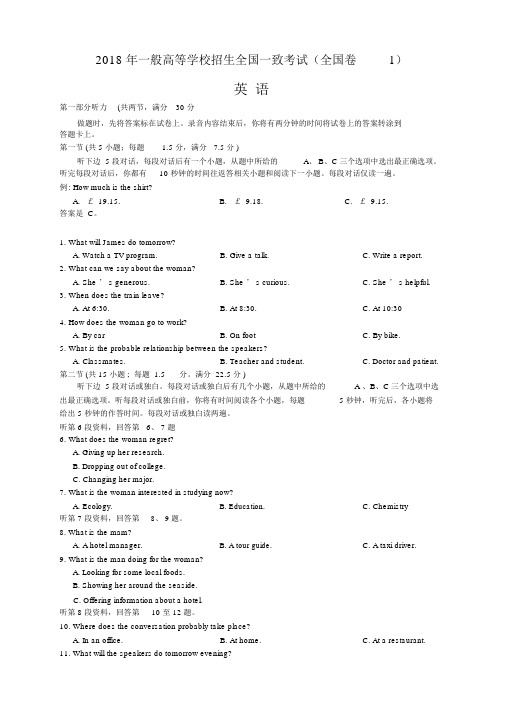
2018 年一般高等学校招生全国一致考试(全国卷1)英语第一部分听力(共两节,满分30 分做题时,先将答案标在试卷上。
录音内容结束后,你将有两分钟的时间将试卷上的答案转涂到答题卡上。
第一节 (共 5 小题;每题 1.5 分,满分7.5 分 )听下边 5 段对话,每段对话后有一个小题,从题中所给的A、 B、C 三个选项中选出最正确选项。
听完每段对话后,你都有10 秒钟的时间往返答相关小题和阅读下一小题。
每段对话仅读一遍。
例: How much is the shirt?A.£19.15.B.£9.18.C.£9.15.答案是 C。
1.What will James do tomorrow?A. Watch a TV program.B. Give a talk.C. Write a report.2.What can we say about the woman?A. She ’ s generous.B. She ’ s curious.C. She ’ s helpful.3.When does the train leave?A. At 6:30.B. At 8:30.C. At 10:304.How does the woman go to work?A. By carB. On footC. By bike.5.What is the probable relationship between the speakers?A. Classmates.B. Teacher and student.C. Doctor and patient.第二节 (共 15 小题 ; 每题 1.5分。
满分 22.5 分 )听下边 5 段对话或独白。
每段对话或独白后有几个小题,从题中所给的 A 、B、C 三个选项中选出最正确选项。
听每段对话或独白前,你将有时间阅读各个小题,每题 5 秒钟,听完后,各小题将给出 5 秒钟的作答时间。
2018年高考英语(全国I卷)试题及答案
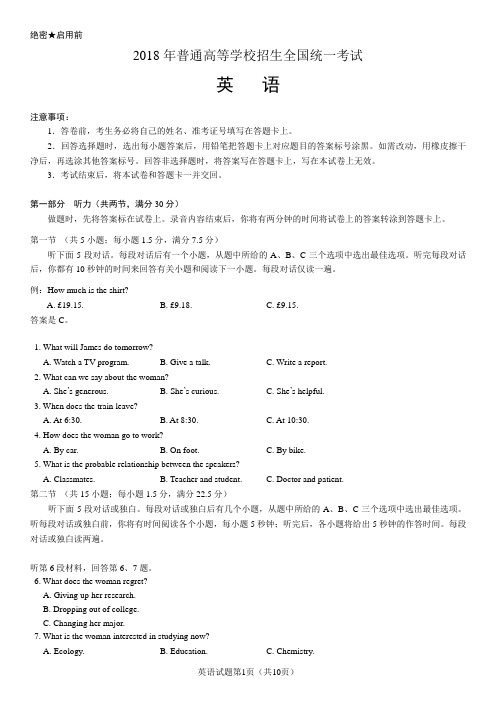
绝密★启用前2018年普通高等学校招生全国统一考试英语注意事项:1.答卷前,考生务必将自己的姓名、准考证号填写在答题卡上。
2.回答选择题时,选出每小题答案后,用铅笔把答题卡上对应题目的答案标号涂黑。
如需改动,用橡皮擦干净后,再选涂其他答案标号。
回答非选择题时,将答案写在答题卡上,写在本试卷上无效。
3.考试结束后,将本试卷和答题卡一并交回。
第一部分听力(共两节,满分30分)做题时,先将答案标在试卷上。
录音内容结束后,你将有两分钟的时间将试卷上的答案转涂到答题卡上。
第一节(共5小题;每小题1.5分,满分7.5分)听下面5段对话。
每段对话后有一个小题,从题中所给的A、B、C三个选项中选出最佳选项。
听完每段对话后,你都有10秒钟的时间来回答有关小题和阅读下一小题。
每段对话仅读一遍。
例:How much is the shirt?A. £19.15.B. £9.18.C. £9.15.答案是C。
1. What will James do tomorrow?A. Watch a TV program.B. Give a talk.C. Write a report.2. What can we say about the woman?A. She’s generous.B. She’s curious.C. She’s helpful.3. When does the train leave?A. At 6:30.B. At 8:30.C. At 10:30.4. How does the woman go to work?A. By car.B. On foot.C. By bike.5. What is the probable relationship between the speakers?A. Classmates.B. Teacher and student.C. Doctor and patient.第二节(共15小题;每小题1.5分,满分22.5分)听下面5段对话或独白。
2018年高考英语(全国I卷)试题及参考答案(word版)
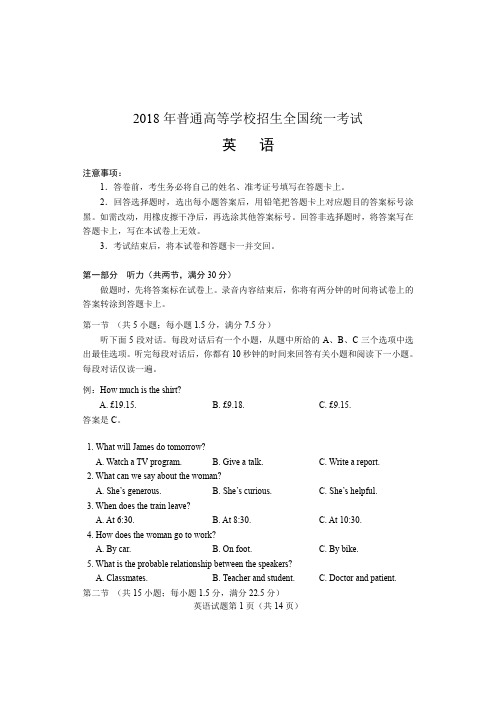
2018年普通高等学校招生全国统一考试英语注意事项:1.答卷前,考生务必将自己的姓名、准考证号填写在答题卡上。
2.回答选择题时,选出每小题答案后,用铅笔把答题卡上对应题目的答案标号涂黑。
如需改动,用橡皮擦干净后,再选涂其他答案标号。
回答非选择题时,将答案写在答题卡上,写在本试卷上无效。
3.考试结束后,将本试卷和答题卡一并交回。
第一部分听力(共两节,满分30分)做题时,先将答案标在试卷上。
录音内容结束后,你将有两分钟的时间将试卷上的答案转涂到答题卡上。
第一节(共5小题;每小题1.5分,满分7.5分)听下面5段对话。
每段对话后有一个小题,从题中所给的A、B、C三个选项中选出最佳选项。
听完每段对话后,你都有10秒钟的时间来回答有关小题和阅读下一小题。
每段对话仅读一遍。
例:How much is the shirt?A. £19.15.B. £9.18.C. £9.15.答案是C。
1. What will James do tomorrow?A. Watch a TV program.B. Give a talk.C. Write a report.2. What can we say about the woman?A. She’s generous.B. She’s curious.C. She’s helpful.3. When does the train leave?A. At 6:30.B. At 8:30.C. At 10:30.4. How does the woman go to work?A. By car.B. On foot.C. By bike.5. What is the probable relationship between the speakers?A. Classmates.B. Teacher and student.C. Doctor and patient.第二节(共15小题;每小题1.5分,满分22.5分)英语试题第1页(共14页)听下面5段对话或独白。
2018年全国I卷高考英语试题答案与解析

2018年全国I卷高考英语试题答案与解析2018年高考英语全国I卷真题解析第二部分阅读理解 (共两节,满分40分)第一节 (共15小题;每小题2分,满分30分)阅读下列短文,从每题所给的A、B、C和D四个选项中,选出最佳选项。
A本文介绍了四种骑自行车游览华盛顿的活动,包括国家广场、国会山、夜间探险和特别主题游。
建议提前预订,骑行时配备反光背心,带瓶装水,有导游带领,适合初来乍到的游客和当地居民。
1.What is the article mainly about?A。
The history of Washington。
D.C.B。
The best ways to explore Washington。
D.C。
by XXX.C。
XXX。
D.C.D。
The dangers of biking in Washington。
D.C.答案:B2.What is the nal Mall?A。
A park in Washington。
D.C。
where nal XXX.B。
A shopping center in Washington。
D.C。
with a nal XXX.C。
A museum in Washington。
D.C。
with a nal n.D。
A hotel in Washington。
D.C。
with a nal n.答案:A3.XXX?A。
The highest point in Washington。
D.C.B。
The n of the U.S。
Capitol building in Washington。
D.C.C。
The name of a hill in Washington。
D.C。
that overlooks the city.D。
The name of a famous building in Washington。
D.C.答案:B4.What is the purpose of the reflective XXX?A。
(完整word版)2018年高考英语全国1卷试卷及答案(清晰word版),推荐文档

绝密★启用前2018年普通高等学校招生全国统一考试英语注意事项:1.答卷前,考生务必将自己的姓名、准考证号填写在答题卡上。
2.回答选择题时,选出每小题答案后,用铅笔把答题卡上对应题目的答案标号涂黑。
如需改动,用橡皮擦干净后,再选涂其他答案标号。
回答非选择题时,将答案写在答题卡上,写在本试卷上无效。
3.考试结束后,将本试卷和答题卡一并交回。
第一部分听力(共两节,满分30分)做题时,先将答案标在试卷上。
录音内容结束后,你将有两分钟的时间将试卷上的答案转涂到答题卡上。
第一节(共5小题;每小题1.5分,满分7.5分)听下面5段对话。
每段对话后有一个小题,从题中所给的A、B、C三个选项中选出最佳选项。
听完每段对话后,你都有10秒钟的时间来回答有关小题和阅读下一小题。
每段对话仅读一遍。
例:How much is the shirt?A. £19.15.B. £9.18.C. £9.15.答案是C。
1. What will James do tomorrow?A. Watch a TV program.B. Give a talk.C. Write a report.2. What can we say about the woman?A. She’s generous.B. She’s curious.C. She’s helpful.3. When does the train leave?A. At 6:30.B. At 8:30.C. At 10:30.4. How does the woman go to work?A. By car.B. On foot.C. By bike.5. What is the probable relationship between the speakers?A. Classmates.B. Teacher and student.C. Doctor and patient.英语试题第1页(共13页)第二节(共15小题;每小题1.5分,满分22.5分)听下面5段对话或独白。
- 1、下载文档前请自行甄别文档内容的完整性,平台不提供额外的编辑、内容补充、找答案等附加服务。
- 2、"仅部分预览"的文档,不可在线预览部分如存在完整性等问题,可反馈申请退款(可完整预览的文档不适用该条件!)。
- 3、如文档侵犯您的权益,请联系客服反馈,我们会尽快为您处理(人工客服工作时间:9:00-18:30)。
2018年全国一卷试题答案解析A篇:21.A由题目中的book in advance可对应第一段最后reserve your spot before availability可推知答案。
reserve→预订,出现在2016年全国三卷语法填空中。
22.D由题目可定位到文章第三段原文“entertain you with the most interesting stories”可知答案。
23.D由bicycle tour可定位到文章最后一段provide v.提供(八年级下册unit3)由文章最后两句,可知答案。
B篇:24.B由文章第一段but后可知,这是题目的答案“but she is cooking up storm in her latest role”但是她正在烹饪在她最新的角色中。
latest最新的(七年级上册)late迟的,晚的→latest adj.最新的。
25.C.由题目定位到第二段“with the help of chef Matt Tebbutt offers top tips on how to reduce food waste.”厨师Matt Tebbutt帮忙提供好的建议关于怎样减少食物浪费。
C选项“Matt”在做饭问题上给susanna提供帮助。
26.由第四段可知,在这里由8部分组成的系列节目中susanna主持.save money:good food.这个节目是紧跟着ITV’s save money:good heal+n这个节目的,交代了Good Food这一部分产生的背景。
27.文章多次体现出文章的主旨:1.第一段最后:how to prepare delicious and nutritious meals on a tight budgetc预算,济源市高三二模完形填空发现。
2.susanna主持的节目Save Money。
3.最后一段中的on a budget,less expensive。
干扰项C:让你自己成为一个完美的厨师,有些片面,文章主旨是在有限的预算下,做出同样美味的食物。
C篇:28.B:由hunter-gatherer times定位到文章第一段第三行“devdoped their own patterns of speech independent of each other代出他们自己的独立于别人的语言类型”及最后一句“they spoke perhaps 12000 languages between them”他们彼此之间讲说的语大概12000种。
29.C:由句意可知,过去几十年间的全球化及更好的交流方式等,已经造成了很多语言的消失,像英语,西班牙语,中文等主流语言将会替代这些消失的语言。
complex复杂的,Advanced高级的,powerful有力量的,modern现代的。
英语,中文等受众人群较多,故选C。
30.B:由6000 people可定位到文章第三段,The median nummber of speakers is a mere 6000,which means that half the world’s languages are spoken by fewer people than that.说话者的中位数是6000人,这意味着时间上一般的语言的使用者是少于6000人的。
31.C:本题考查文章主旨,由文章第二段“trade industrialisation the development of…,have caused many language to disappear.”贸易,工业化,及各方面的发展,已经造成很多语言的消失。
文章第一段“Languages have been coming and going for thousands of years,but in recent times there has been less coming and a lot more going”语言的新生和消失已存在成千上万年了,但是最近,新生的语言越来越少,消失的语言越来越多。
D篇32.A:文章第一段,That’s bad news for the environmen…as the outdated devices comsume much more energy than the newer ones。
对环境来说,这是个坏消息,因为老的装置比新的会消耗更多的能量。
33.D:定位到文章第二段:To figure out how much power these devices are using.为了确定这些装置消耗多少能量。
Babbitt的团队做了这个研究。
34.B:题目中关键词:the least energy 最少的能源。
文章最后一句“Viewing on tablets instead of TVs and desktop computers could cut energy consumption by 44%在平板上而不是电视或电脑上看节目会减少44%的能源消耗”35.A:由32,34两题可知,旧设备会消耗更多的能源,因此,我们要停止使用它们,而转向新设备。
第二节阅读理解七选五36.B.上文“creating rooms you’ll love to live in,wang a room,looking for a place”可知,应选B,无论你在寻找什么,颜色是非常重要的。
37.A.虽然他们都很有用,但是他们有点复杂。
they指上文提到的“a number of different techniques”38.D.由上文“the small ones,the medium ones and the large ones”可知39.G.选项中a step up from the small ones即指的是medium ones. two major ways则指的是空后的两个方面。
40.F. the time,effort,and relative expense put into 指的是时间,努力及金钱方面的付出,对应选项中的pays to,be sure,及解释为什么会有这些付出的原因。
完形填空41.B42.C:由上文free course 免费课程可知,这里是节约一些钱。
43.A:即使我不会因为免费的学分高兴,我们的老师对我也是很有吸引力的,故本题应填与appeadling。
44.D:由下文an international grandmaster意义相近的词,各国际大师,可知选instructor导师。
45.D.这意味着我将会向游戏最出色的一位老师学习。
46.C.参考45题。
47.B:因此,我都等不及要见他了。
48.D.:Maurice Ashley 是学校的毕业生,但这个工作对他来说不是游戏,而是生意。
故本题所填内容应与business相对。
49.C.在他的介绍中,他清楚地告诉我们学分是很难获得的。
make it clear说清楚。
50.B:为了考过这门课程,除了其他的标准,我们不得不写一篇关于我们计划怎样把我们课堂上所学的知识应用到我们未来的工作,最终到我们的生活中去。
51.C。
参考50题。
52.A。
参考50题。
53.C.在这门课上我得了A,并且学到了一直很好帮助我的超于课堂之外的生命课程。
54.B.参考53.55.A.学习象棋课十年后,我仍然应用他所教授给我的。
56.D.下象棋时,你所学到的最重要的机能是怎样去做好决定。
57.B.参考56.58.A.在你每一次的移动中,你都必须分析这个情况,思考你的对手在做什么,然后从你所有的选择中去评估最好的一个,本空的选项应与process意义相近。
59.D.参考58.60.A.这些话仍然是正确的,在我充当记者的角色中。
一.语法填空:61.longer:由than可知,此处应用形容词比较级。
62.to see:1.本句中or连接fast和for long(状语),可以忽略,则空之前是动词run,且其后没有特殊搭配,则用to连接两个动词。
2.由句意可知,to do不定式表目的。
你不需要跑很快或很长时间来看效果。
63.dying:prep+doing,本词在九年级unit2单词dead学习时进行拓展,die v.死,death n.死,dying现在分词/adj.濒死的。
64.is:由says可知本句的一般现在时,且主语it,故用单数is。
65.than:本句中是主语it即running与walking,cycling,swimming进行比较,有more可知,本空应填比较级的标志词than66.that/which:由前面名词a study及后面动词showed可知,符合定从的普通考查形式,即从句中缺主语,且a study是物,故用which/that。
67.cause:可数名词,前面all可知,后面用可数名词复数。
2017年全国一卷,完形填空19题答案B cause V.造成 n.引起,原因。
68.strengthen:to后跟动词原形,表目的,本词发现于九年级unit2 stranger n.陌生人→strange adj.奇怪的→strong adj.强壮的→strength n.力量→V. strengthen 加强69.energetic:系动词后用形容词,九年级unit8 energy n.能量→energetic adj.精力充沛的。
70.it/running:give后要跟双宾语,故本空要填一个代词,在众多代词中“it”脏活累活都能干,在这里指代running。
